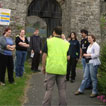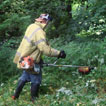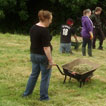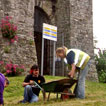Oystermouth Castle is a familiar site in Swansea. It was rescued in the middle of the 19th century by local antiquary George Grant Francis, who employed workmen at his own expense to clear out the rubble and restore the walls, including a painstaking reconstruction of the chapel window from fragments of fallen tracery. It is thanks to him that we still have the building to enjoy. Read more about the history of the castle
In the 150 years since then, many architectural historians have studied the standing remains, and we have a good idea of how they all inter-relate. However, the only time we have ever looked below the surface of the ground is when service trenches have been put in, such as for the electricity for the floodlights. Sometimes these have given us tantalising glimpses of what lies hidden - for example, the outer wall of the eastern tower of the gatehouse. In 2006, the Friends of Oystermouth Castle commissioned a geophysical survey of the castle’s surroundings and its Inner Ward. Unfortunately, the weather was too wet to produce very good results, but it showed enough to suggest that the surviving buildings did not stand alone, and there are probably others under the grass outside. However, we also know that this area was divided into fields earlier in the 19th century, and some of the walls that show on the geophysics may be field boundaries.
For the 2010 programme we propose to excavate in two locations, The Knoll and the area to the north of the castle.
- The Knoll: We propose to re-open Trench 1 of the 2009 excavation season in an attempt to obtain a complete profile of the ditch. This will entail moving the trench slightly to the south to the south, to pick up the ditch's southern lip, and widening it by an estimated 2m at either side, so that the sides can be stepped in at 1m in order to provide safe working conditions to a depth of 2-3m, which is estimated as being the likely depth of the ditch. This will enable us to establish whether the defensive capabilities of the castle were commensurate with those suggested by the massive buttressing at the base of the gate towers, or whether the latter was a cosmetic feature designed for show rather than serious use, like the wall-walk of Swansea Castle. The eastern end of Trench 3 was not completely excavated in 2009. We therefore propose that the easternmost 4m should be re-opened if time allows, so that this end can be completely explored. However, this is considered as low priority and would only be carried out if Trenches 4 and 5 proved to be negative and could be backfilled before the end of the excavation.
- The saddle to the north of the castle: There is some dispute as to whether the earthworks planned by RCAHMW investigators represent the remains of a bailey, as they suggest (RCAHMW 2000, 247) or a quarry (Davies 2006, 2). As vegetation conditions here are likely to make excavation difficult, we suggest that excavation be limited to two small trenches, each 2m x 5m, one (Trench 4) to be situated on the higher ground north of the central block, and the other (Trench 5) in the base of the square depression that occupies most of the northern half of the northern saddle.



